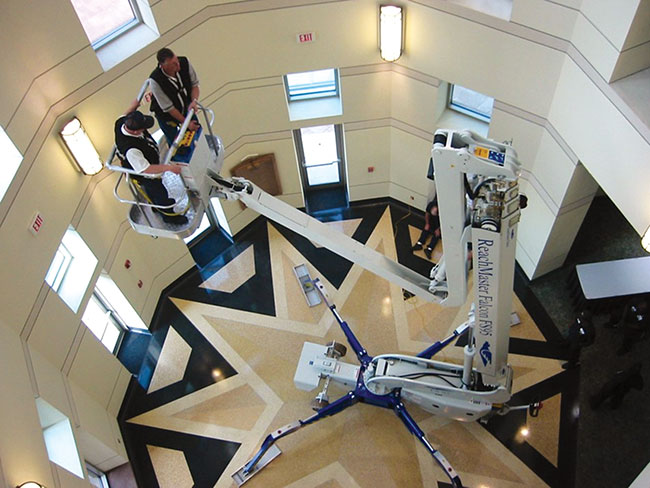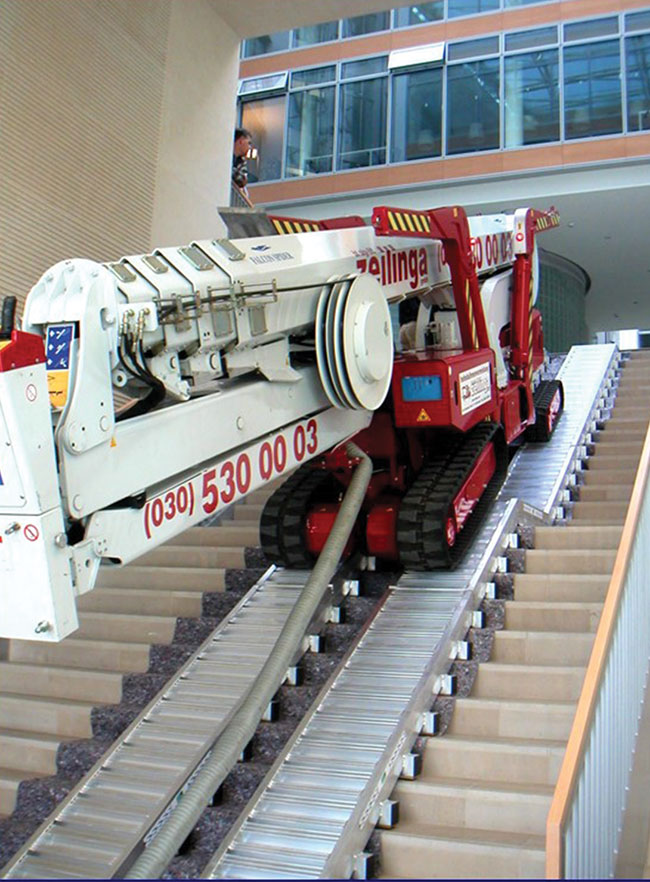
Think big, operate small
By Ebbe Christensen
Features Tech tipsOnce upon a time, a 125-year-old community centre needed to work on its 40-foot-high ceiling with only a standard door for access. And the compact aerial lift was born.
Once upon a time, a 125-year-old community centre needed to work on its 40-foot-high ceiling with only a standard door for access. And the compact aerial lift was born.
 |
|
| Reaching high places in tight spaces is what the new generation of atrium lifts is all about. Most models are are designed with tracks and tires that will not damage delicate flooring.
|
It all started with a front door to a community building in Odense, Denmark, a small town otherwise unknown to the world apart from being the birthplace of Hans Christian Andersen, the fairytale poet. In 1976, this 125-year-old community building had a big problem that required a small solution. It needed ceiling repairs at the “staggering” height of 40 feet, but the only access was through a single door and the 125-year-old wooden floor could only sustain very limited impact. Scaffolding could not be used as workers had to reach out over an opening and some permanent installations that could not support scaffolding. They needed a lift.
The owner contacted a small local aerial lift manufacturer, known for its innovative truck-mounted aerial lifts, and explained they needed something like one its truck lifts without the truck. It should also be lightweight, go through their single front door, be self-propelled and operate on batteries. Last, but not least, it should be safe and easy to use.
Six months later, in 1977, the manufacturer – E. Falck Schmidt A/S – presented the solution. The world’s first compact aerial lift that could reach the 46-foot work height was built on a 2.6-foot-wide chassis with three wheels so it could drive through the door. It was equipped with adjustable outriggers substituting for counterweights and powered by a battery pack to run the hydraulic drive motors and lift actuators.
The manufacturer realized that its innovative solution to help a local community facility had birthed a new global industry. Like the famous fairytale poet, the company had written the first chapter of its own story. As they would come to learn years later, a lot of customers actually considered it a fairytale when they tried to explain that their 138-foot work height lift still could go through a single door and their biggest unit, now at 180 feet work height, only needed a double door.
New ideas based on the old principles
Fast forwarding to today, almost 40 years later, the Danish company has been joined by several other European manufacturers to form an entire new industry. The supply and variety of the so-called compact aerial lifts – also known as atrium lifts – has never been bigger and is today divided into two main categories, generally referred to as either wheel-based or track-based units. Interestingly enough, the original company – now known in North America as ReachMaster – nailed the design concept of what would become the core principle for all compact lifts in their very first attempt in 1977: a narrow chassis, equipped with four outriggers that swing out, with a boom system on a rotating turret run by hydraulics and powered by a battery pack.
From the humble beginnings of a 46-foot work height, manufacturers today offer multiple solutions with work heights from 39 to 172 feet. Manufacturers from Denmark, Germany and Italy have added new ideas to the basic concept, and each contributed to the evolution of the compact lift industry. Their combined efforts have changed the way many industries are working.
The first units operated strictly on conventional battery power, but today a wide combination of power choice is available. These include conventional and lithium DC batteries, direct AC supply, gas, diesel and a combinations of these in the so-called hybrid versions. However, the most important common feature they all bring to the market is safer access at height replacing decades of dangerous and “creative” methods of working at height.
Safety first
The compact format combined with substantial work height often prompts the question, are they safe to use? The answer is yes, and in many ways the dynamics of outrigger-based lifts offers a safer approach to working at height compared to other options.
First, as opposed to other lift solutions, you cannot drive an atrium lift at height, thereby eliminating the tip-over situations where an operator mistakenly drives a unit beyond its stability parameters.
Secondly, sensor systems in the outriggers ensure that the platform of the lift is set up correctly, locked and that sufficient support is established before the aerial lift functions become operational. They also serve the purpose of detecting if there are any changes in the support surface and will immediately shut down the lift in case of an incident.
Third, the advanced use of CAN bus steering systems in some of the lifts on the market today allows for a number of added safety features where a unit automatically will detect overloading, driving at dangerous angles (slopes), and some can even detect if the basket is approaching an obstacle and shut down the unit before the operator hits a window or a wall.
The biggest contribution to safety is the ability to replace other access methods, including ladders, suspended equipment, aerial transfers and other methods to reach those difficult areas that cannot otherwise be reached by conventional lifts.
Wheel based
The category started with wheel-based units in 1977 and today remains be the preferred solution for indoor applications. The wheel-based versions offer maximum maneuverability because of their steering abilities. Opposite the track-based versions that steer by moving the tracks in opposite directions, the wheel-based units offer up to 180-degree front-wheel steering. Combined with a much smaller footprint under the wheels than tracks, these units represent the least impact on any delicate surface.
Most importantly, and true to the original concept, the wheel-based units remain the only lifts that can access an area through a three-foot single door, yet provide work heights from 72 to 138 feet. Being designed for indoor or outdoor use, the wheel-based units do require a solid and relatively level surface.
Tracked based
The track-based concept has grown in popularity given its ability to travel on uneven surfaces, and thereby represents an alternative to much bigger outdoor lifts. While designed mostly for outdoor use, thanks to the power alternatives available today they can also be used indoors.
The smaller units up to about 60 feet work height provide single-door access like the wheel-based units, while the bigger units from 70 to 170 feet work height need a double door. That in itself is a major achievement, which allows architects the freedom to create tall atriums that otherwise never could be maintained.
Applications
The compact lift has slowly changed how entire industries work today. Window cleaners no longer hang from a rope but have their feet safely planted in a basket combined with a much larger work range translating into higher productivity. Large facilities like airports, convention centers or shopping malls no longer have to close down an entire section for weeks to erect scaffolding but can move lifts in and out of the area to conduct work during off hours. And tree care professionals no longer have to climb hazardous dead old trees in back yards because they can’t get their bucket trucks in, but can work from a compact lift next to the tree.
Any combination of limited access, ground pressure restrictions and a need for significant work height represents a prime application for compact lift equipment. Additionally, the horizontal outreach capabilities of the compact lift solves common applications such as reaching out over escalators, openings to floors below and reaching up and over permanent installations. Thanks to the versatility of these lifts, they can often combine the need for several lifts into one, changing the lift inventory of both end-users and rental companies. Obviously, larger cities represent the highest concentration of applications, but uses for compact lifts can be found anywhere.
 |
|
| Sometimes an atrium lift is the only way to reach the top of large indoor spaces in malls, sports stadiums, hospitals and other commercial spaces.
|
High ROI opportunities for the rental industry
The conclusion that European rental companies came to in the ‘80s finally manifested itself among rental companies first in the U.S., and now slowly also Canada, where acceptance of the compact category as a permanent part of rental fleets is growing. While the process has started, the population concentration in large Canadian cities represents an untapped market with great growth potential for those companies that engage in the segment.
It took almost 20 years before ReachMaster as the first European manufacturer established its own presence in North America in the mid-1990’s. Teupen from Germany followed in 2008 with permanent representation and today more than a dozen manufacturers offers compact solutions through distributors. Today most of the taller units come from primarily Denmark (ReachMaster Falcon and Omme Lift) as well as Germany (Teupen and Denka) with Italian CMC and Platform Basket offering a few models above 70-foot work height.
Virtually everything else below that work height comes from Italian manufacturers, including Bluelift, Platform Basket, CMC, Hinowa (marketed in North America as a private label by JLG), Oil & Steel, Easy Lift and Cormidi.
“Think big, but operate small” has finally come to North America.
Print this page
Leave a Reply